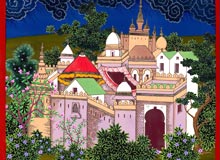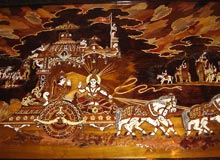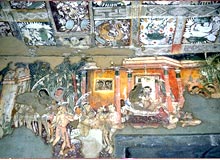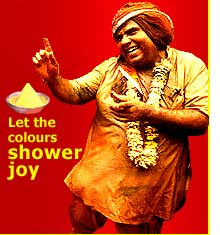
Mughal painting reflects an exclusive combination of Indian, Persian and Islamic styles. As the name suggests, these paintings evolved as well as developed during the rule of Mughal Emperors in India, between 16th to 19th century. The Mughal paintings of India revolved around themes, like battles, court scenes, receptions, legendary stories, hunting scenes, wildlife, portraits, etc. The Victoria and Albert Museums of London house a large and impressive collection of Mughal paintings.
History of Mughal PaintingIndian Mughal paintings originated during the rule of Mughal Emperor, Humayun (1530-1540). When he came back to India from the exile, he also brought along two excellent Persian artists, Mir-Sayyid Ali and Abd-us-samad. With time, their art got influenced by the local styles and gradually; it gave rise to the Mughal painting of India. The earliest example of the Mughal style is the Tutinama ('Tales of a Parrot') Painting, now in the Cleveland Museum of Art. Then, there is the 'Princess of the House of Timur', a painting redone numerous times.
Growth of Mughal PaintingMughal paintings of India developed as well as prospered under the rule of Mughal Emperors, Akbar, Jahangir and Shah Jahan.
Under AkbarMughal painting experienced large-scale growth under the reign of Emperor Akbar. During that time, hundreds of artists used to paint under the direction of the two Persian artists. Since the Emperor was fond of tales, one can see the paintings mainly being based on the Mahabharata, Ramayana and Persian epics. Mughal paintings also started illustrating an enhanced naturalism, with animal tales, landscape, portraits, etc.
Under JahangirEmperor Jahangir reigned from 1605 to 1627 and extended great support to various art forms, especially paintings. This period saw more and more refinement in brushwork, along with the use of much lighter and subdued colors. The main themes of the Mughal paintings revolved around the events from Jahangir's own life, along with portraits, birds, flowers, animals, etc. One of the most popular examples of Mughal paintings of this time include the pictorial illustrations of the Jehangir-nama, the biography of Emperor Jahangir.
Under Shah JahanThe grace and refinement of the Jahangir period was seen at the time of Emperor Shah Jahan (1628-1658). However, the sensitivity of the paintings was replaced by coldness and rigidity. The themes of that time revolved around musical parties, lovers on terraces and gardens, ascetics gathered around a fire, etc.
Decline of Mughal PaintingThe trend that was seen during the time of Shah Jahan was also found under the rule of Aurangzeb (1658-1707). However, the emperor did not pay too much attention on the growth of the Mughal paintings. Still, the art form continued to survive with the support received from its other patrons. However, gradually, because of diminishing support, a declining trend set in. The time of Muhammad Shah, (1719-1748), did experience a brief revival of the Mughal paintings. Nonetheless, with the arrival of Shah Alam II (1759-1806), the art almost became extinct and another school of painting, known as Rajput paintings, started evolving.
Mysore Paintings

Mysore Painting is a form of classical South Indian painting, which evolved in the Mysore city of Karnataka. During that time, Mysore was under the reign of the Wodeyars and it was under their patronage that this school of painting reached its zenith. Quite similar to the Tanjore Paintings, Mysore Paintings of India make use of thinner gold leaves and require much more hard work. The most popular themes of these paintings include Hindu Gods and Goddesses and scenes from Hindu mythology. The grace, beauty and intricacy of Indian Mysore Paintings leave the onlookers mesmerized.
History of Mysore PaintingsIt was under the rule of Raja Krishna Raja Wodeyar that the popularity of the Mysore School of painting reached its highest point. However, after the Raja expired in 1868, the artists started scattering and the school reached the point of total extinction. The year 1875 saw the establishment of Jagan Mohan Palace and Chitrakala School and along with it, the revival of the Mysore Painting of India. Late Sri Siddalingeswara Swamiji and late Sri Y. Subramanya Raju also contributed to this exquisite art form.
Centers of Mysore PaintingsIndian Mysore School of paintings exists in Mysore, Bangalore, Narasipura, Tumkur, Sravanabelagola and Nanjangud.
Making Mysore PaintingsA number of steps are involved in the process of producing a Mysore painting. The first step requires the artist to make a preliminary sketch of the image on the base, which comprises of a cartridge paper pasted on a wooden base. Thereafter, he makes a paste of zinc oxide and Arabic gum, known as 'gesso paste'. This paste is used to give a slightly raised effect of carving to those parts of the painting that require embellishments and is allowed to dry. Then, gold foil is pasted onto the surface. The rest of the painting is prepared with the help of watercolors. After the painting is fully dried, it is covered with a thin paper and rubbed lightly with a smooth soft stone.
In the traditional Mysore paintings, all the inputs were made by the artists, including brushes, paints, board, gold foil, etc. Instead of the poster colors and watercolors of today, vegetable and mineral colors were used. Even the base was formed of paper, wood, wall and cloth, rather than the sole cartridge paper base used now. The sketches were made with the help of charcoal, which was prepared by burning tamarind twigs in an iron tube. The brushes were made of different materials, like squirrel hair, camel hair, goat hair, etc.
Cave Paintings in India

Cave paintings of India date back to the prehistoric times. The finest examples of these paintings comprise of the murals of Ajanta, Ellora, Bagh, Sittanavasal, etc, which reflect an emphasis on naturalism. Ancient cave paintings of India serve as a window to our ancestors, who used to inhabit these caves. In the following lines, we have provided more information on the ancient Indian rock paintings:
Ajanta PaintingsAjanta caves are located at a distance of approximately 100 km from the city of Aurangabad. Most of the paintings seen in the Ajanta Caves, date back to the period of the Mahayana sect of Buddhism. The themes of most of these paintings revolve around the life and teachings of Lord Buddha. This includes the Jataka stories related to the various lives and incarnations of Buddha. Calligraphic lines characterize these paintings, which can be classified into portraits, narrative illustrations and ornamental decoration.
Ellora PaintingsEllora caves are nestled amidst the Chamadari Hills, lying approximately 18 miles to the northeast of Aurangabad city. Paintings can be found in five caves. However, all of them are today preserved only in the Kailasa temple. The rock paintings of Ellora were painted in two different series. The first series, which were done when the caves were carved, revolve around Lord Vishnu and Goddess Lakshmi. The second series, painted centuries later, illustrate procession of Shaiva holy men, Apsaras, etc.
Bagh Paintings Bagh caves, situated on the banks of the Bagh River, have been excavated on the rock face of a lofty hill. The wall paintings of these caves date back to period between 5th and 7th century. These paintings represent the mast exquisite traditions of Indian art form.
Sittanavasal PaintingsSittanavasal is the site of an ancient Jain Monastery, located at a distance of around 58 km from Trichy. The monastery is known for housing some of the most exquisite frescoes in a rock cave. Most of these cave paintings are based on the Pandyan period of the 9th century. The themes of these paintings include animals, fish, ducks, people collecting lotuses from a pond, two dancing figures, etc. Apart from that, one can also find inscriptions dating back to the 9th and 10th century. The ceiling of the Ardhamandapam is adorned with murals from the 7th century.
 Mughal painting reflects an exclusive combination of Indian, Persian and Islamic styles. As the name suggests, these paintings evolved as well as developed during the rule of Mughal Emperors in India, between 16th to 19th century. The Mughal paintings of India revolved around themes, like battles, court scenes, receptions, legendary stories, hunting scenes, wildlife, portraits, etc. The Victoria and Albert Museums of London house a large and impressive collection of Mughal paintings.
Mughal painting reflects an exclusive combination of Indian, Persian and Islamic styles. As the name suggests, these paintings evolved as well as developed during the rule of Mughal Emperors in India, between 16th to 19th century. The Mughal paintings of India revolved around themes, like battles, court scenes, receptions, legendary stories, hunting scenes, wildlife, portraits, etc. The Victoria and Albert Museums of London house a large and impressive collection of Mughal paintings. Mysore Painting is a form of classical South Indian painting, which evolved in the Mysore city of Karnataka. During that time, Mysore was under the reign of the Wodeyars and it was under their patronage that this school of painting reached its zenith. Quite similar to the Tanjore Paintings, Mysore Paintings of India make use of thinner gold leaves and require much more hard work. The most popular themes of these paintings include Hindu Gods and Goddesses and scenes from Hindu mythology. The grace, beauty and intricacy of Indian Mysore Paintings leave the onlookers mesmerized.
Mysore Painting is a form of classical South Indian painting, which evolved in the Mysore city of Karnataka. During that time, Mysore was under the reign of the Wodeyars and it was under their patronage that this school of painting reached its zenith. Quite similar to the Tanjore Paintings, Mysore Paintings of India make use of thinner gold leaves and require much more hard work. The most popular themes of these paintings include Hindu Gods and Goddesses and scenes from Hindu mythology. The grace, beauty and intricacy of Indian Mysore Paintings leave the onlookers mesmerized. Cave paintings of India date back to the prehistoric times. The finest examples of these paintings comprise of the murals of Ajanta, Ellora, Bagh, Sittanavasal, etc, which reflect an emphasis on naturalism. Ancient cave paintings of India serve as a window to our ancestors, who used to inhabit these caves. In the following lines, we have provided more information on the ancient Indian rock paintings:
Cave paintings of India date back to the prehistoric times. The finest examples of these paintings comprise of the murals of Ajanta, Ellora, Bagh, Sittanavasal, etc, which reflect an emphasis on naturalism. Ancient cave paintings of India serve as a window to our ancestors, who used to inhabit these caves. In the following lines, we have provided more information on the ancient Indian rock paintings:
